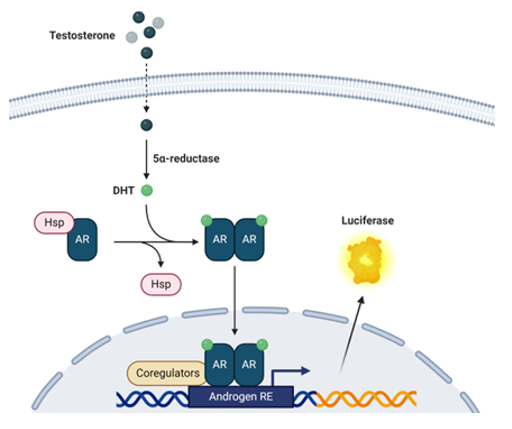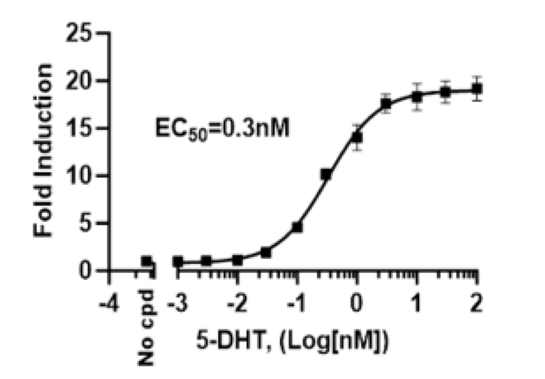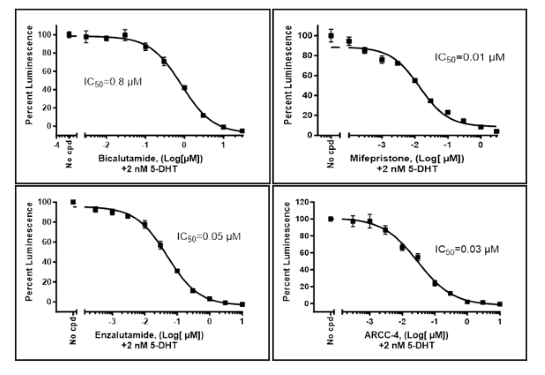Androgen Luciferase Reporter 22RV1 Cell Line
Androgen Luciferase Reporter 22RV1 Cell Line is a human 22Rv1 cell line with a stably integrated Firefly luciferase reporter under the control of an androgen response element. This cell line monitors the activity of the androgen receptor signaling pathway.
This cell line has been validated in cellular assays involving the inhibition of 5α-Dihydrotestosterone (5-DHT)-induced reporter activation by AR (androgen receptor) antagonists such as Enzalutamide, Bicalutamide, Mifepristone and ARCC-4.

Figure 1: Mechanism of action of Androgen Luciferase Reporter 22RV1 Cell Line in response to testosterone.
Interested in screening and profiling inhibitors or activators of androgen receptor without the need to purchase and license the cell line? Check out our Immunotherapy Cell-Based Screening Services.
Purchase of this cell line is for research purposes only; commercial use requires a separate license. View the full terms and conditions.
Media Required for Cell Culture
| Name | Ordering Information |
| Thaw Medium 2 | BPS Bioscience #60184 |
| Growth Medium2M | BPS Bioscience #78181 |
Materials Used in Cellular Assay
| Name | Ordering Information |
| Assay Medium 2C | BPS Bioscience #78544 |
| 5α-Dihydrotestosterone (5-DHT) | Sigma-Aldrich #D-073 |
| Enzalutamide | MedChem #HY-70002 |
| Bicalutamide | MedChem #HY-14249 |
| Mifepristone | Cayman #10006317 |
| ARCC-4 | MedChem #HY-130492 |
| Clear-bottom, white 96-well tissue culture-treated plate | Corning #3610 |
| ONE-Step™ Luciferase Assay System | BPS Bioscience #60690 |
| Luminometer |
The cell line has been screened to confirm the absence of Mycoplasma species.
AR (androgen receptor), also known as NR3C4 (nuclear receptor family 3, group C, member 4) is a nuclear receptor involved in regulating gene expression. It is activated by testosterone and dihydrotestosterone, and it has been linked to prostate cancer. Prostate cancer is the most frequently diagnosed cancer and the second-leading cause of cancer death in American men. AR remains functional and is expressed in nearly all primary prostate cancers, with endocrine therapy aiming at reducing serum androgens and inhibiting AR. The androgen-induced transcriptional activation of AR is modulated by the interaction of AR with coregulators and by phosphorylation of AR and AR coregulators in response to growth factors. However, prostate cancer can almost always adapt to survive under castration levels of androgen or to AR inhibition. Castration resistance may involve AR point mutations, overexpression, changes in androgen biosynthesis, expression of constitutively active AR splice variants (active in the absence of ligand binding), and changes in androgen cofactors. As AR activity remains important in the progression of all stages of prostate cancer, AR continues to be an attractive molecular target of drugs against prostate cancer. 22Rv1 cell line is derived from a human prostate cancer xenograph propagated in mice and it is known to form tumors in nude mice. It is mostly dihydrotestosterone-independent for growth but responds to EGF (epidermal growth factor). They express androgen receptor (AR) that responds to androgen stimulation, making it one of the few available cellular models for prostate cancer studies.
Heinlein C.A. and Chang C., 2004 Endocr Rev. 25(2):276-308.
Lonergan P.E., and Tindall D.J., 2011 J Carcinog. 10:20.
Salami J., et al., 2018 Commun Biol 1:100.



